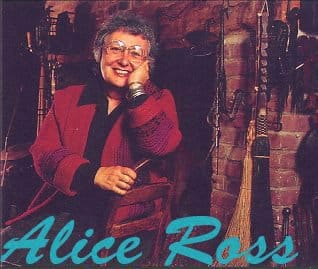Hearth to Hearth: Frontispieces of Old Cookbooks – The Journal of Antiques and Collectibles – March 2001
At the beginning of many a cook book is a frontispiece, an illustration that tells us something about the culinary aspirations of its author. No matter what its theme, it promotes the cookbook as a harbinger of current dining fashion. Sometimes it alludes to a well-appointed kitchen, sometimes it puts forth the portrait of its presumably famous and prestigious author-chef, and sometimes it makes a social or political statement. Either way, these introductory graphics are often worth attention, as they offer both artistry and information.
Sadly for us, all cookbooks did not incorporated frontispieces. In such cases one can only supply an imaginary image—in fact, that kind of exercise is a kind of game that helps to place a work in its genre. The following authentic samples are examined in that way, having been chosen for their variety and their statements.
The first published European cookbook was In Hoc Volumine Hec Continentur, written by Bartolomeo Platina (Rome, 1475). Its initial picture had more to do with the Pope and his court than cookery. It may seem surprising that this was more a political dedication than a reference to cookery until one examines Platina’s long career as a scholar in the Vatican world and his ultimate appointment as the official (and possibly the first) Papal librarian. His cook book acknowledged that most of his manuscript was taken from the work of Martino, the talented chef to the powerful and sybaritic papal treasurer Cardinal Trevesian. As one must in the world of power, Platina had thrived by maneuvering politically, currying favor, and adapting to a series of popes and changing policies.
One hundred years later, an early German cookbook, Ein Brundtli the Belchreibung/wei manrecht und rool… by M. Marren Rumpolt, (Franckfort am Main, 1587) shows the changes coming about under the Reformation. His frontispiece included a complex picture of two corpulent cooks, perhaps husband and wife, at work in their kitchen. The scene is framed in a somewhat idyllic border of decorative scrollwork that made use of opulent food references. The large mullion window at the back suggests that this was more than an ordinary family. A bank stove (a large blocky construction with fires underneath, a precursor of the Victorian cook stove) holds a mechanical spit turning a roast. Resting on what may be a raised hearth nearby are assorted kettles on the boil. An ample supply of utensils abounds on the floor and on tables; in all they suggest various aspects of cooking and baking.
This is not the huge kitchen of a Vatican prince or German royalty, but more likely a substantial middle-class household. There is affluence enough for mechanical equipment, great numbers of utensils, assorted expensive ingredients, and time and fuel enough for complex cookery. The cooks themselves are probably not a family cooking for themselves in their own home (middle class men would not be cooking with their wives). More likely they are a hired chef and his assistant working in a well-fixed household. Their girth indicates authority and prosperity, classic Germanic images. This frontispiece proclaims a growing middle class that can now support an expanded cuisine, that can benefit from cookbooks and a kitchen staff, and that can turn its eye to fashion at the table.
In another hundred years, a Dutch cookbook aimed its recipes and its messages to housewives themselves. The Netherlands had achieved high levels of material success through active colonization and mercantile trade, and had developed a strong urban middle-class culture in which women were active and independent agents in the business world. De Verstandige Kock, a seventeenth century Dutch cookbook, shows a busy kitchen, a large dutch oven at work over a blazing tiled stove, and a cauldron hanging from the fireplace trammel. The food itself tells us how wealthy this depicted family is. An assortment of game hangs aging, and at the hearth two large spits roast meats. Under the roasts (what appears to be three red meat roasts and three chickens), dripping pans catch the juices, to be used in the rich sauces that commonly used cream, eggs, butter, spices, and wines. If this is not enough, yet another spit is being threaded with some kind of meat, and a platter of fish await the cook’s attention (hopefully before the cat gets to it). This amount of meat smacks of privilege, perhaps even a festive meal for a large gathering. Alternating feasting and frugality characterized Dutch culture—this clearly refers to the feast. Even a wealthy colonial power such as the Netherlands could not support the common consumption of meat daily.
The size and extent of the cooking fires likewise suggests privilege, as the Dutch had limited wood for cooking fires and generally exercised thrift in typical soups or one-dish meals. It is significant that in the far corner a third fire heats a bake oven for the pastry we see being rolled out at the work area. Again we see a pair of cooks—another man and a woman—who are probably servants. Although the picture is hard to make out, one may be making standing meat pies, yet another indication of a special occasion. Like that of Rumpolt, this frontispiece announces that you will find high-status food among its recipes, an appropriate claim as the cost of the book itself may have limited its market to the affluent middle class.
At about the same time, Robert May produced his English cookbook, The Accomplisht Cook, Or The Art & Mystery of Cookery (London, 1685). Mr. May was not a middle-class cook but rather an important professional chef, having trained in France and served European aristocracy before his return to England. It is not surprising, considering his expertise and position, that his frontispiece was his portrait. Although this glorification of self and reputation set the tone, it is interesting to find him representing himself modestly as a plainly dressed, un-wigged figure in the anti-monarchy Cromwellian style. His anti-aristocratic likeness was reinforced with a poem pronouncing his dedication to “Gusto” and “Nature’s plentie.” In reacting against European haute cuisine and its “excesses,” he supported an ideal English upper class cuisine that was, by comparison, plainer and more wholesome, and which would become characteristic of British cookery despite its growing wealth.
In the next century this theme was borne out and developed. The English manor house was coming into its own, as we see in Bradley’s The Country Housewife and Lady’s Director, In The Management of a House, and the Delights and Profits of a Farm, 6th ed. (London, 1786). In accordance with his title, the frontispiece emphasized the working areas of the farm, the stately manor house and imposing ornamental gardens only visible in the distance. In the foreground we find women churning butter and a large number of servants (peasants?) busily involved in drawing water, milking, tending cows, sheep, and poultry, harvesting grain and apples and making wine. To add to this bucolic vision, a small river provides water power to a mill, fishing, and transportation. Bradley’s book offered not only substantial advice on food production, but also fine recipes for their cookery according to the highest London standards.
Many of these cookbooks were taken by colonists to the New World. However, one sees a marked change in the frontispieces of American cookbooks written after the War for Independence. Lydia Maria Child’s American Frugal Housewife (New York: 1832) has discarded beauty and high fashion for economy and practicality. Her introductory print is a set of butchering charts, identifying the important cuts of mutton, pork, veal, and beef. What could be more in keeping with the new republic, its farming citizens, and its focus on practicality, frugality, and hard work? Here are no signs of fancy dress, elaborate cookware, or bids for aristocracy.
In the same vein is The Improved Housewife (anonymous, Hartford, 1845), whose frontispiece is a handsome rooster and the admonition,
“The cock doth crow, to let you know, If you be wise, what time to rise.”
Fortunately or unfortunately, such modesty didn’t last out the century. By the 1890s, in the throes of the American Industrial Revolution, Americans were gadget- and fashion-hungry, and cookbook frontispieces reflected it. H. M. Kinsley’s One Hundred Recipes For The Chafing Dish (New York: 1894) begins with a well-dressed hostess presiding over her table. And Mrs. Rorer’s New Cook Book (Philadelphia, 1898) had no less than three frontispieces, each a table top set for a successive breakfast course. She saw fit to display intricate, matching services—glassware, dishware, and flatware, coffee service, and centerpieces, each arranged correctly for this complex morning meal. Status is again a matter of displayed material wealth, leisure, and etiquette.
And thus it is only to be expected that by the turn of the century a cult of superstar cook book authors and cooking teachers had developed through the proliferation of magazine and newspaper articles across the nation. Marion Harland, one of the leading lights of the cook book world, was entirely on the mark by using her portrait to introduce her new Complete Cook Book (Indianapolis, 1903), dedicated “for the housewife, not the chef.” There she is, sitting graciously smiling at a formal tea table, about to pour.
What kind of frontispieces do we find today? And what do they say about who we are? Actually, a sampling of modern cookbooks shows that they are disappearing. Perhaps they have outlived their function. We now have endless possibilities for illustrations within the text; and perhaps less need for introductory pictures. Our current passions for the twenty-minute meal, for health, or for ethnic and regional cuisines are reflected in more cook book publication than ever before. Being easily recognized, these genres speak for themselves and need fewer introductions. Perhaps, in our world of fast pace and instant gratifications, it is the fanciful book jacket, making a dramatic bid for the eye of the browser, which has become the new frontispiece.
Alice Ross brings 25 years as a dedicated food professional teacher, writer, researcher and collector to her Hearth Studios, at which she teaches workshops in various aspects of hearth, woodstove and brick oven cookery. She has served as consultant in historical food for such noted museums as Virginia’s Colonial Williamsburg and The Lowell National Historical Park in Massachusetts. Ross wrote her doctoral dissertation in food history at the State University at Stony Brook. Currently, she is involved in a major kitchen report on Rock Hall Museum, a 1770’s Georgian mansion on Long Island. Dr. Ross’ e-mail address is aross@binome.com. Her web site is www.li.net/~aross
[amazon_carousel widget_type=”SearchAndAdd” width=”550″ height=”200″ title=”More on Hearth cooking:” market_place=”US” shuffle_products=”True” show_border=”False” keywords=”Open Hearth Cooking” browse_node=”” search_index=”Books” /]





Related posts: